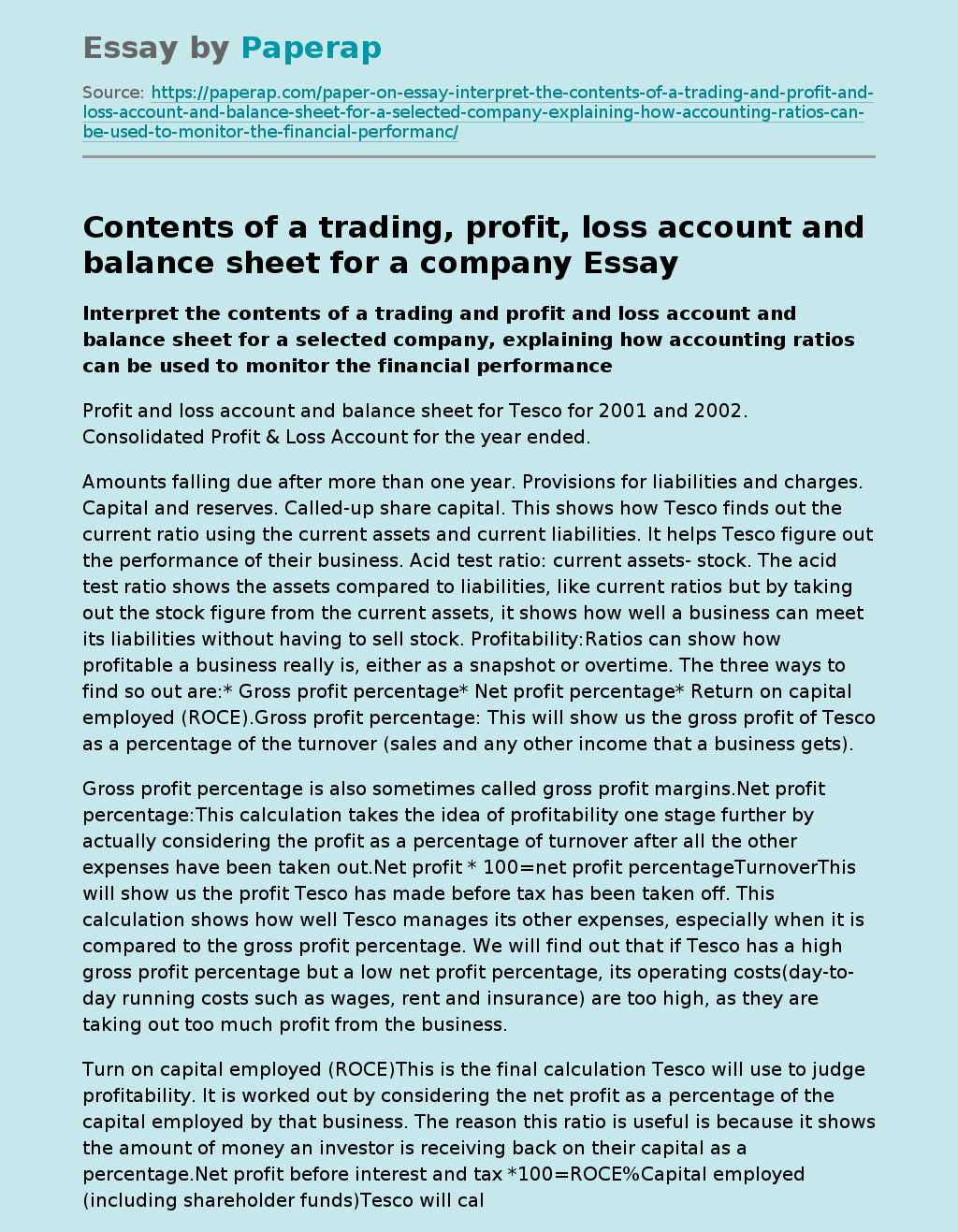Contents of a trading, profit, loss account and balance sheet for a company
Interpret the contents of a trading and profit and loss account and balance sheet for a selected company, explaining how accounting ratios can be used to monitor the financial performance
Profit and loss account and balance sheet for Tesco for 2001 and 2002. Consolidated Profit & Loss Account for the year ended.
Amounts falling due after more than one year. Provisions for liabilities and charges. Capital and reserves. Called-up share capital. This shows how Tesco finds out the current ratio using the current assets and current liabilities.
It helps Tesco figure out the performance of their business. Acid test ratio: current assets- stock. The acid test ratio shows the assets compared to liabilities, like current ratios but by taking out the stock figure from the current assets, it shows how well a business can meet its liabilities without having to sell stock. Profitability:Ratios can show how profitable a business really is, either as a snapshot or overtime. The three ways to find so out are:* Gross profit percentage* Net profit percentage* Return on capital employed (ROCE).
Gross profit percentage: This will show us the gross profit of Tesco as a percentage of the turnover (sales and any other income that a business gets).
Gross profit percentage is also sometimes called gross profit margins.Net profit percentage:This calculation takes the idea of profitability one stage further by actually considering the profit as a percentage of turnover after all the other expenses have been taken out.Net profit * 100=net profit percentageTurnoverThis will show us the profit Tesco has made before tax has been taken off.
This calculation shows how well Tesco manages its other expenses, especially when it is compared to the gross profit percentage. We will find out that if Tesco has a high gross profit percentage but a low net profit percentage, its operating costs(day-to-day running costs such as wages, rent and insurance) are too high, as they are taking out too much profit from the business.
Turn on capital employed (ROCE)This is the final calculation Tesco will use to judge profitability. It is worked out by considering the net profit as a percentage of the capital employed by that business. The reason this ratio is useful is because it shows the amount of money an investor is receiving back on their capital as a percentage.Net profit before interest and tax *100=ROCE%Capital employed (including shareholder funds)Tesco will calculate its debtor’s collection period which looks at the link between the number of debtors and how long on average it takes the business to collect its debts. Tesco calculates the debtor’s collection period in the following formula:
Debtors * 365=total number of days it takes debtors to pay
Credit sales
The final ratio that will help Tesco work out the performance of a business is asset turnover.Sales = asset turnoverTotal assetsAsset-based ratio analyses are very useful to Tesco looking at trends in their performance to see how well they are making use of their assets.D2: Evaluate the adequacy of accounting ratios as a means of monitoring the state of the business in a selected organisation, using examples.
Accounting ratios cannot always be good enough for monitoring the state of the business. For a large business like Tesco the accounting ratios cannot be good enough for the state of the business.Tesco can have information problems. Ratios are not definitive measures for a large organization like Tesco. Ratios need to be interpreted carefully.
They can provide clues to the company’s performance or financial situation. But on their own, they cannot show whether performance is good or bad. Ratios require some quantitative information for an informed analysis to be made. This can put down the performance of Tesco. It can stop Tesco from moving on and making success as they would not know the exact state of Tesco as if they are making profit with their sales or they are facing loss.The information can be outdated in financial statement. The figures in a set of accounts are likely to be at least several months out of date, and so might not give a proper indication of the company’s current financial position. Tesco might not even be able to find out what exactly the current state of the market is and how their business is doing.Financial statements contain summarized information.
Ratios are based on financial statements which are summaries of the accounting records. Through the summarization some important information may be left out which could have been of relevance to the users of accounts. The ratios are based on the summarized year end information which may not be a true reflection of the overall year’s results. This means that Tesco can lose information that could have been very important for the business. This can lead them to loss. Interpretation of ratios is important for the businesses specially a large organization like Tesco. It is difficult to generalize about whether a particular ratio is ‘good’ or ‘bad’. For example a high current ratio may indicate a strong liquidity position, which is good or excessive cash which is bad. Similarly Noncurrent assets turnover ratio may denote either a firm that uses its assets efficiently or one that is undercapitalized and cannot afford to buy enough assets. Any of this information does not help Tesco monitor the state of Tesco. Like asset turnover and current ratio or any of the percentages do not benefit Tesco anyhow. They do give a clue about the state of Tesco but they do not exactly tell Tesco about the state of Tesco. It does not exactly monitor the state of Tesco.
Contents of a trading, profit, loss account and balance sheet for a company. (2018, Aug 24). Retrieved from https://paperap.com/paper-on-essay-interpret-the-contents-of-a-trading-and-profit-and-loss-account-and-balance-sheet-for-a-selected-company-explaining-how-accounting-ratios-can-be-used-to-monitor-the-financial-performanc/

